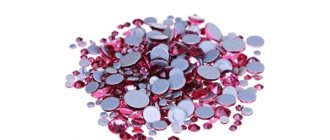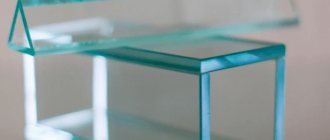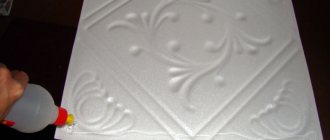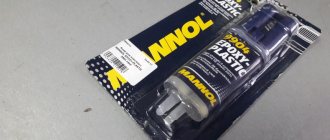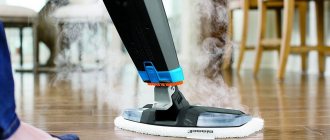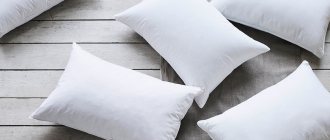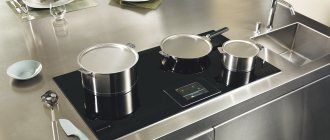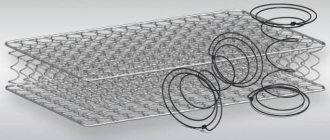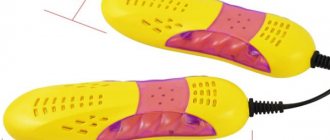PVA (polyvinyl acetate) glue is widely used for gluing fabric. Attaching decor to textiles, repairing and gluing seams is not only done using the standard method: thread and needle. Fabric glue is different from other types because the manufacturer assumes that the fabric will wash, bend, etc. Textile glue is an excellent alternative to thread, because it contains substances that prevent the appearance of puffs. The glue can be used for decoupage, clothing repair, appliqué, when processing seams, etc.
In this list we will try to figure out which glue is best, but we warn you - it is not an easy task! All of these adhesive compositions are considered the best among consumers.
Textile glue Prym Textil 968008
Volume : 30 g.
Price : 344 rub.
Textile adhesive Prym Textil 968008 glues various materials: rubber, leather, wood, PVC, etc. Widely used for hems of curtains and curtains. Once the glue dries, it becomes completely clear, so you no longer have to worry about nasty stains.
Washing textiles with glue on them is allowed at a temperature of no more than 40 degrees. The products from the German company have already been appreciated by many for their high quality. The only negative: some buyers are faced with an unpleasant situation - when ordering glue online, they receive it in a dried form. Please check the adhesive on site when you order.
Gluing the patch with an iron
Often you have to make a patch to disguise a hole in your clothing. For these purposes, you need to choose a sticker and a piece of adhesive interlining that will keep the edges of the hole from coming apart. Instructions for performing actions:
If the hole is large, you can grab the edges with threads so that they do not move apart.
If desired, it is easy to create an application with your own hands. You need to cut out a beautiful picture from a plastic bag, attach it to the place where it should be, cover the picture with a clean sheet of paper and press with a hot iron for about 30 seconds. After cooling, remove the paper and check the result.
Thermal transfers are a great way to decorate, update or repair clothing.
. This makes it possible to stick team logos on sportswear and make other distinctive marks. The main thing is that all this is easy to do with your own hands at home. You can choose thermal transfers to your liking or order the production of new ones based on drawings and photographs. This significantly expands the possibilities for decorating and caring for clothes.
Attention, TODAY only!
- First you need to prepare a hard, flat surface. This could be an ironing board or a table. Can also be glued on the floor. You need to place a fabric folded several times on the table or floor.
- Lay the product flat so that there are no folds or wrinkles.
- Heat the iron and turn off the steam function.
- Place the applique face down in the marked area.
- To avoid damaging the fabric, you can place a sheet of paper on top of the iron-on adhesive.
- Place the heated iron in place with the sticker, press as hard as possible and hold the iron for 8-15 seconds until the picture is completely glued.
- If the size of the picture is larger than the sole of the iron, then in order to glue the thermal stickers onto clothes, you need to apply pressure in parts. Be especially attentive to small fragments and edges. They can be re-treated with a hot iron.
- Let the picture cool a little, but don't wait until it's completely cool.
- Carefully remove the paper - it's best to do this while it's still warm.
- If the design is evenly printed on the fabric, then the gluing was successful.
- Iron the area with the sticker from the inside out.
Thermal transfer film is made of PVC. On one side there is a printed picture, the other side contains hot-melt adhesive, which is activated when heated and glues the print to the textile.
Thermal adhesives differ in thickness and texture of the material. There are the following types of such applications:
- Flex - thermal transfer films with a smooth front side.
- Flock is a film with a velvety front side.
- For thin fabrics characterized by increased elasticity.
- With effects (contain metallized particles, holographic, with 3D printing).
- Reflective (the surface shines in the dark when illuminated).
- Light-accumulating, which accumulate light energy during the day and glow in the dark.
- If the base of the sticker is transparent, it is better to iron it through gauze.
- If the sticker comes off after washing, it can be restored using adhesive web.
- Items with thermal images should be washed in a gentle cycle, and you should not wring them too hard.
In order to make an applique at home, you need to select a thermal transfer that matches the fabric of the product on which the patch is glued. For thin cotton and knitwear, a sticker with a thin base is suitable, while for jeans and jackets, stickers with a thicker base, such as fabric, will be required.
Having chosen a sticker, you can start working:
Sewline water-soluble glue stick
Volume : 7 g.
Price : 430 rub.
Sewline glue sticks were created using innovative technology, thanks to which the fabric can be washed and bent without fear that the glued seams will come apart. This glue easily joins layers of fabric intended for sewing, and after that it is also easy to wash off with water.
After drying, the glue leaves no traces. Thanks to the interesting idea, it is very convenient to use the glue - the rod extends. You can immediately purchase a package of replacement rods. Externally, the glue is almost indistinguishable from the pen, and only after you open the cap you will see blue glue.
Procedure for working with thermal stickers
Despite the fact that there is a wide variety of thermal adhesives, application is approximately the same. The procedure is usually as follows:
- clothes are pre-prepared on a horizontal surface;
- The thermal print is placed with the wrong side down;
- cover with protective material on top;
- the iron is heated to the highest possible temperature;
- press on the decal under the paper for 10-60 seconds.
Krylon spray adhesive
Volume : 400 ml.
Price : 995 rub.
Aerosol adhesive Krylon spray adhesive is ideal for artistic and decorative works. It does not contain acids, so you will not see any stains on the fabric. In addition to paper, glue is also used for gluing:
- parchment;
- paper;
- canvas;
- photos;
- decoupage, etc.
Before use, be sure to treat the product: it must be clean. The glue is applied from a distance of 20-40 cm in a smooth movement from left to right. Since the can is flammable, it should not be sprayed near a fire. It is advisable to ventilate the room when working. The glue is made in the USA.
Useful tips
Advice from professionals will help you glue fabrics together or make decoupage as efficiently as possible:
- Clean the areas to be glued from threads and other objects that may impair the adhesion of surfaces.
- The main thing when working with glue is accuracy, since it will be almost impossible to correct flaws. To avoid trouble, protect the areas from possible drops of glue.
- Consider the specific use of clothing or products that will be glued. For example, only the most durable and strong composition is suitable for a robe. Light, delicate glue that does not change its color after hardening and does not leave stains is suitable for a summer sundress made of thin fabric.
- If the glue comes into contact with the skin, use compounds made exclusively from environmentally friendly ingredients. This will avoid allergies and irritations.
Universal glue KORES
Volume : 125 ml.
Price : 367 rub.
The adhesive made in the Czech Republic is suitable for more than just gluing fabric. It also bonds wood and plastic. Judging by the numerous reviews, KORES deserves attention.
The glue is universal and suitable for any surface, but be careful - it is toxic, so it is recommended to store it out of the reach of children. Sold in different volumes: 500 g, 1000 g, 20 g, etc. The glue has a high bonding rate and can withstand 5 freeze/thaw cycles at -18°C.
Application
Glue for gluing fabric to fabric is used in the following processes:
- Processing the edges of various clothes - the bottom of a skirt, the sleeves of a jacket or blouse and others.
- For designer clothing in the form of a combination of various fabrics and patches.
- For applying various patterns and applications to textiles.
- For finishing the bottom of curtains, curtains, tulle.
- For upholstery of furniture and other works in this field.
You can see what the glued and processed elements look like in the photo.
Permanent adhesive for fabric PEBEO Setacolor
Volume : 45 ml.
Price : 1,020 rub.
Whatever you want to glue, PEBEO Setacolor will do it perfectly. It is suitable for fabric, cardboard, wood and other materials. The fabric can be washed 48 hours after the glue has been applied to the product. Optimal temperature: 40 degrees. The composition does not tolerate freezing.
PEBEO is a French company that also produces paints, thanks to which artists create incredibly beautiful paintings! The paints of this company do not fade or peel - one can judge its products by this fact alone. The glue is suitable for any type of fabric; it is recommended to apply it with a sponge, brush or pipette (whatever you have on hand).
Review of suitable brands
There are six common manufacturers producing high-quality neoprene adhesive.
Aquasure
A universal adhesive mixture used for working with rubber materials. Aquasure is used for more than just wetsuit restoration. It is also used to glue other equipment used in water sports.
Among the features of Aquasure is that it does not lose elasticity even after hardening. This allows you to use this composition for gluing surfaces at bends. The volume of one tube of glue is thirty grams, thanks to which it is possible to treat a considerable area at a time.
Picasso
This is another well-known manufacturer that specializes in the production of high-quality adhesive mixtures for gluing rubberized materials.
Many experts consider Picasso products to be the ideal choice for gluing neoprene material. This adhesive composition is resistant to high humidity and reliable. If you glue a suit with Picasso adhesive, the seam will not come apart for 3-4 years.
Bostic
This is a high-quality adhesive, which is made on the basis of starch, dispersion and PVA. Some people believe that it is used only for gluing neoprene, but this is far from the case.
“Bostik” is distinguished by its versatility, as it is fixed on many different surfaces. It has reliable adhesion to concrete, brick, wood and plastic coatings. It can also be used to secure fabric materials.
Stormopren
This is a two-part adhesive that is often used to repair drysuits. Many people who repair watersports equipment consider Stormopren to be the best adhesive for bonding neoprene. The product contains components that make it possible to reliably fix rubber coatings. The adhesive reliably glues latex, leather surfaces, as well as fabrics and rubber. However, it is not recommended to use Stormopren for gluing building materials, since the composition will not provide reliable fixation.
Sargan
People who are looking for means to repair wetsuits should turn their attention to products manufactured by Sargan. It is a universal adhesive often used for repairing leather goods and water equipment.
Also suitable for gluing artificial leather coverings.
The product is sold in tubes, the volume of which is fifty milliliters. However, in stores you can also find larger tubes of 100-150 milliliters.
Technisub
If you need to quickly glue products made from neoprene, you can use Technisub. The main feature of this composition is that it sticks quickly. The applied liquid begins to set within one minute after application. In this case, the glue completely hardens after 20-25 hours. The advantages of Technisub include its ease of use. To glue parts, simply degrease the surface to be treated and apply glue to it.
Textile glue Gutermann HT2
Volume : 30 g.
Price : 299 rub.
Gutermann HT2 adhesive is designed for working with natural materials, suitable for gluing cotton, linen, felt, and denim. Widely used in creativity, where it is necessary to glue various applications.
Freshly applied textile glue can be easily washed off with water, but only under one condition - while it is “fresh”. At the time of application, the glue is white, but subsequently loses color, becoming transparent. According to buyers, it is more profitable to buy glue on the Internet; there is a markup for it in stores. Glues the yarn tightly, just one drop is enough.
Gluing the patch with an iron
Often you have to make a patch to disguise a hole in your clothing. For these purposes, you need to choose a sticker and a piece of adhesive interlining that will keep the edges of the hole from coming apart. Instructions for performing actions:
If the hole is large, you can grab the edges with threads so that they do not move apart.
If desired, it is easy to create an application with your own hands. You need to cut out a beautiful picture from a plastic bag, attach it to the place where it should be, cover the picture with a clean sheet of paper and press with a hot iron for about 30 seconds. After cooling, remove the paper and check the result.
Thermal transfers are a great way to decorate, update or repair clothing. This makes it possible to stick team logos on sportswear and make other distinctive marks. The main thing is that all this is easy to do with your own hands at home. You can choose thermal transfers to your liking or order the production of new ones based on drawings and photographs. This significantly expands the possibilities for decorating and caring for clothes.
Glue Moment textiles
Volume : 20 g.
Price : 224 rub.
Moment glue , because it is sold in almost every hardware store. But did you know that there is also a separate type of it – the moment for gluing textiles? Waterproof adhesive perfectly bonds a wide range of materials and is a durable, water-resistant substance.
There are a number of things that glue will not accept, these are:
- rubber;
- polypropylene;
- polyethylene;
- glass;
- silicone rubber.
Also not suitable for dishes that contain hot liquids. The setting time is only 1 minute - after this time you can enjoy the fruits of your creativity!
UHU Alleskleber universal glue
Volume : 60 ml.
Price : 189 rub.
This adhesive is suitable for a variety of materials, be it porcelain, ceramics or fabric. The glue is made on the basis of synthetic resin, which came into use relatively recently - at the beginning of the last century.
The glue is water resistant, so the fabric can be washed. UHU Alleskleber can withstand temperatures up to +120 degrees, ideal for household work, as well as hobbies and modeling. Before work, do not forget to prepare the surfaces - they must be clean and dry. The glue is made in Germany, which inspires confidence among many.
How to use iron-on to close a hole in fabric?
If the main task of a thermal adhesive is to close a small defect on clothing, namely to hide a hole, then you should follow a few simple recommendations.
- Before purchasing an applique, measure the length and width of the hole so that the thermal sticker covers it completely;
- the torn product must be ironed well in the area of the tear so that the edges align;
- Before applying the applique, make sure that there are no creases and the fabric lies flat;
- Place the thermal adhesive face up and apply a well-heated iron. If you are afraid of damaging the fabric, you can additionally use gauze;
- After waiting the required amount of time, carefully remove the hot surface and wait for the application to cool completely;
- After making sure that the thermal sticker has stuck well, you can wear the product.
It is important not only to follow the rules for applying such drawings, but also for their storage. Thermal adhesives do not tolerate damp conditions, so they should only be stored in a dry place. The thing is that the adhesive layer gets damp and destroyed very quickly, so storing applications in the bathroom is not the best idea. The same applies to solar radiation, try to avoid direct contact with the material.
If, after washing, the thermocoil has slightly separated from the material, then the situation can be corrected with the help of a special adhesive web. To prevent such situations, you should wash the products on which the applique is applied in a gentle mode and do not use aggressive detergents for washing.
A hole in an item can be decorated using thermal appliqué, this is especially true for outerwear. If you can stick a sticker on pants or a T-shirt in the usual way, then in case of damage to a jacket or snowsuit we will need a suitable applique and a piece of thin non-woven fabric.
How to glue thermal stickers on outerwear?
- Place the interlining through the torn front fabric of the product. The adhesive layer should be on top.
- Straighten so that there are no folded edges.
- Iron with a hot iron, carefully aligning the edges of the “wound”.
- Place a thermal sticker on the front side.
- Iron it also with a hot iron. If you are not sure about the effect of temperature on the fabric, you can iron it through gauze or a thin rag.
- Let it cool and then check if the applique has stuck well.
Textile glue UHU Textil
Volume : 19 g.
Price : 331 rub.
UHU Textil glue is designed for gluing a variety of fabrics: felt, coconut thread, jeans, linen and many other fabrics. The glue cannot be used on silk, as well as on those fabrics where the proportion of synthetic fibers is more than 60%. When dry, the substance acquires a transparent color and retains elasticity.
Gluing surfaces couldn't be easier: apply glue to one surface, and then connect it to the other, pressing lightly. It only takes 5 minutes to dry. After 30 minutes, the fabric can be ironed to give it stability.
Types and types of adhesive composition
To decide which glue is best to choose for working with fabric, you need to study the most relevant types:
- Rubber glue. To glue elements of a suit or other clothing made of any fabric without stains or marks, you can use rubber-based glue. To do this, apply a thin layer of the substance to the surfaces intended for gluing and let it dry. After an hour, a film forms on the surface; it must be lubricated with acetone and the materials must be combined. To ensure good adhesion and strength, you need to press down the glued areas with a weight.
- Perchlorovinyl glue. It needs to be applied in 2 layers, after applying the first you need to wait for it to dry completely. This happens in 10 minutes, and then a second layer is applied and left to dry for 3 minutes. After gluing the surfaces, you need to roll out the seam with a roller for uniform distribution and place a weight on the material for 2 days.
- Fabric glue “liquid thread”. It has a transparent consistency. To glue the surfaces, you need to apply the composition in a thin, even layer and after a few seconds fasten to each other, pressing firmly.
- Nitrocellulose composition. After applying it, you need to connect the materials immediately, and then press them down with a load.
- Polyvinyl acetate glue is applied to the 2 surfaces to be glued, after a couple of minutes they need to be tightly connected and pressed down with a weight.
